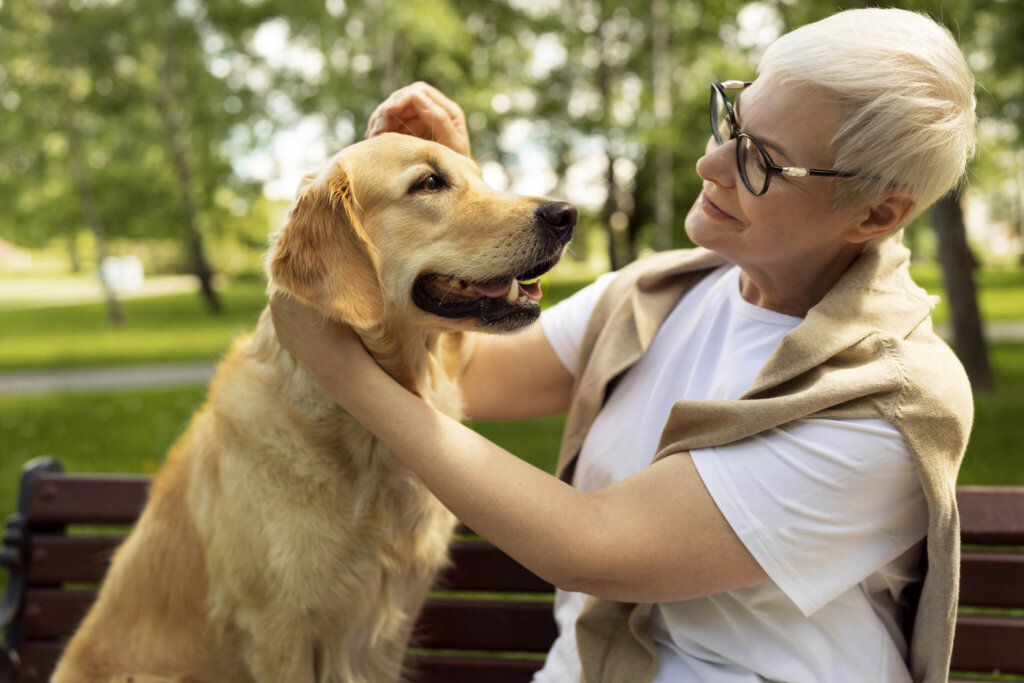How to Work Out the Age of a Dog

When we adopt a dog, we may not know anything about its history or even its date of birth. Even if we have no idea how old it is, there are some methods used by experts to make a fairly rough estimate of its age. Do you want to find out how to judge the age of a dog?
Dogs don’t age at the same rate as we do, in fact, they age much faster and their longevity is less. Moreover, this aspect is variable according to breed and size. In this article we’ll tell you how to estimate the age of your dog, so don’t miss it.
How to get to know the age of a dog
There are different ways to determine the age of a dog. Although they aren’t as accurate as knowing the exact day of their birthday, they can give us an approximate idea of how old they are.
Knowing this figure helps us to improve their quality of life; for example, with an adequate diet or exercise routine according to the animal’s age.
The veterinarian can tell the age of a dog through a physical examination and some tests. One of the most commonly used methods is a dental examination.
However, it isn’t the only one. X-ray diagnosis of tendons and checking the progression of bone ossification can also be performed. Internal organ examinations or ophthalmological evaluations, useful for adult dogs, are also performed.
A study published in the journal Tierarztliche Praxis suggests that several parameters can be used to determine the age of a dog, such as the following:
- Dimension of light reflection in the lens of the eye
- Dental abrasion
- Dental tartar
Although the research examined 295 dogs, the results were scattered, which shows the difficulties that can arise when determining the life span of dogs.
A genetic test is now also used with the study of dog DNA, which consists of an analysis of the length of the telomeres of the chromosomes. This is an important assessment for estimating the lifespan of dogs.
Can you tell how old a dog is by its teeth?

As we have stated, you can estimate the age of a dog based on the observation of its teeth: the teeth is currently has, the dental wear, or even the tartar. A dog’s teeth change as it grows. However, there are variations in some breeds when the teeth come out a little later.
At the beginning, the dentition is made up of 28 deciduous (or milk) teeth and then these fall out to give way to the permanent ones, with a total of 42 teeth, among which we can distinguish:
- 12 incisors
- 4 canines
- 16 premolars
- 10 molars
How to get to know the age of a puppy by its teeth?
In the case of dogs in their puppy stage, age is determined based on the teeth in their mouth. The incisor teeth are characterized by a 3-lobed end, known as the fleur-de-lis.
Wear in this region of the fleur-de-lis also provides information on how long the animal has been alive. Below, we’ll detail the way in which the teeth appear, according to data presented by the Association of Spanish Veterinarians Specializing in Small Animals (AVEPA):
- 0 to 14 days: Dogs have no teeth. In addition, their eyes and ears are closed and they show reflex responses, such as the sucking reflex.
- 15 to 20 days: Fangs and upper incisors appear. The fangs erupt on day 15. The incisors erupt on the following days, first the end ones, then the middle ones, and finally the central ones.
- 20 days: The lower fangs appear.
- 21 to 30 days: The lower incisors emerge, first the end ones, then the middle ones, and then the central ones.
- 1 to 3 months: The incisor teeth wear down, losing their fleur de lis and a leveling or shaving occurs in both the upper and lower teeth.
- 3 and a half months: The permanent teeth begin to appear, in this case, the lower central incisors.
- 4 months: The permanent upper central incisors emerge.
- 4 and a half months: The permanent middle incisors appear, both upper and lower.
- 5 months: At this time the permanent upper canines emerge.
- 1 year: When the dog reaches this age, the permanent incisive arcade is complete, with its fleur-de-lis evident. In addition, the teeth are white and clean.
How can you tell the age of an adult dog by its teeth?
Just as the wear and tear of the incisor teeth serves to determine certain stages of a dog’s life when it’s a puppy, in the case of the adult, the situation is similar. In the following list we offer you the changes according to age, let’s take a look:
- 1 to 2 years: Little by little the teeth change their white tone; they become duller and even a little yellowish.
- 2 and a half years old: Some wear begins to appear on the teeth, the fleur de lis disappears from the lower central incisors.
- 3 to 5 years: Wear continues on the incisor teeth, both upper and lower.
- From 6 years of age onwards: The fangs also suffer wear and tear, changing their pointed shape to a blunt one. Dental tartar may also appear.
Signs of aging in the older dog
In the case of older dogs, there’s more damage and wear on the teeth (as you would expect). More tartar appears and some teeth can even be lost. Dental diseases are also common at this stage.
There are also other signs that are evident in older dogs that don’t have to do with their teeth. Among them, it is important to mention ophthalmologic problems. At this age, aging of the crystalline lens (lenticular sclerosis) can occur, in which the eyes become cloudy or bluish.
They can also suffer from cataracts. The American Kennel Club Association states that 50% of dogs over 9 years old and almost all dogs over 13 years old suffer from these eye diseases, either one or both.
Similarly, older dogs lose their muscle tone and their hind legs become weak. They usually have low energy levels and like to sleep more. Gray hair also appears in their coat, initially near the mouth, but then often spreading to other areas of the face and body.
The age of a dog in human years

There is a popular belief that 1 year of a dog’s age is equivalent to 7 human years. Therefore, if a dog is 3 years old, it is comparable to a 21-year-old person. However, today we know that this isn’t true.
Experts have tried to find the best way to make this comparison. They determined that dogs and humans do not age at the same rate, so it is impossible to run that linear similarity with the 7 years.
The study was conducted by researchers University of California, in which they established a new calculation formula based on certain changes that occur in the DNA of the dog. In this way an epigenetic clock is provided, which can predict the biological age of the animal more accurately.
Finding out the approximate age of your pet
According to what we’ve mentioned today, we’ve seen that it’s possible to tell the approximate age of a dog, even if we don’t know their date of birth. Although the methods used aren’t as precise as to name the exact day, they do provide valuable approximations, which help us to improve their quality of life.
All cited sources were thoroughly reviewed by our team to ensure their quality, reliability, currency, and validity. The bibliography of this article was considered reliable and of academic or scientific accuracy.
- American Kennel Club. (26 de diciembre de 2021). How to calculate dog years to human years. Consultado el 01 de mayo de 2023. https://www.akc.org/expert-advice/health/how-to-calculate-dog-years-to-human-years/
- Asociación de Veterinarios Españoles Especialistas en Pequeños Animales. (s.f.). Consultado el 01 de junio de 2023. https://avepa.org/pdf/Informe_denticion_y_edad_perros.pdf
- Buschman, H. (2 de julio de 2020). How dogs actually age (and what that tells us about how we do). University of California. Consultado el 02 de junio de 2023. https://www.universityofcalifornia.edu/news/how-dogs-actually-age-and-what-tells-us-about-how-we-do
- Fick, L., Fick, G., Li, Z., Cao, E., Bao, B., Heffelfinger, D., Parker, H., Ostrander, E., & Riabowol, K. (2012). Telomere length correlates with life span of dog breeds. Cell Reports, 2(6), 1530-1536. https://www.sciencedirect.com/science/article/pii/S2211124712004184
- Geiserich, K., Failing, K., & Neiger, R. (2015). Age determination in dogs using ocular light reflection, dental abrasion and tartar. Tierarztliche Praxis. Ausgabe K, Kleintiere/Heimtiere, 43(05), 317-322. https://www.thieme-connect.com/products/ejournals/abstract/10.15654/TPK-140974
- Horvath, S., Lu, A. T., Haghani, A., Zoller, J. A., Li, C. Z., Lim, A. R., Brooke, R. T., Raj, K., Serres-Armero, A., Dreger, D. L., Hogan, A. N., Plassais, J., & Ostrander, E. A. (2022). DNA methylation clocks for dogs and humans. Proceedings of the National Academy of Sciences of the United States of America, 119(21), e2120887119. https://www.biorxiv.org/content/10.1101/2021.03.30.437604v1.abstract
- Horvath, S., Lu, A. T., Haghani, A., Zoller, J. A., Brooke, R. T., Raj, K., … & Ostrander, E. A. (2021). Epigenetic clock and methylation studies in dogs. bioRxiv, 2021-03. https://www.biorxiv.org/content/10.1101/2021.03.30.437604v1.abstract
- Hunter, T., & Ward, E. (2023). Lenticular sclerosis in dogs. VCA Animal Hospitals. Consultado el 02 de junio de 2023. https://vcahospitals.com/know-your-pet/lenticular-sclerosis-in-dogs
- Loraszko, G., Racz, B., & Ozsvari, L. (2022). Changes in the dentition of small dogs up to 4 months of age. Animals, 12(11), 1417. https://www.mdpi.com/2076-2615/12/11/1417
- Meyers, H. (17 de noviembre de 2023). How to Tell Your Dog’s Age. American Kennel Club. Consultado el 01 de junio de 2023. https://www.akc.org/expert-advice/health/how-to-tell-dog-age/
- Tobias, G., Tobias, T. A., & Abood, S. K. (2000). Estimating age in dogs and cats using ocular lens examination. Compendium, 22(12). https://www.researchgate.net/publication/298604604_Estimating_Age_in_Dogs_and_Cats_Using_Ocular_Lens_Examination
- Van den Broeck, M., Stock, E., Vereiren, Y., Verhaert, I., Duchateau, P., & Cornillie, P. (2022). Age estimation in young dogs by radiographic assessment of the canine pulp cavity/tooth width ratio. Anatomia, Histologia, Embryologia, 51(2), 269-279. https://onlinelibrary.wiley.com/doi/abs/10.1111/ahe.12787
- Williams, K., & Lerner, R. (s.f.). Teeth, teething and chewing in puppies. VCA Animal Hospitals. Consultado el 01 de junio de 2023. https://vcahospitals.com/know-your-pet/teeth-teething-and-chewing-in-puppies#:~:text=Dogs%20do%20not%20have%20any,deciduous%20teeth%20have%20fallen%20out
